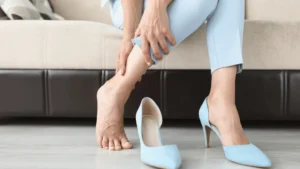High Arch Feet: Understanding the Implications and Care
Introduction: High arch feet, also known as pes cavus, is a condition where the arch of the foot is significantly raised, causing a variety of symptoms and potential complications. While some individuals with high arch feet may experience no discomfort or issues, others may face challenges in everyday activities such as walking or running. Understanding the implications, causes, and necessary care for high arch feet is crucial in managing this condition effectively.

Overview
The typically curved arch of the foot is designed to distribute body weight evenly and absorb shock during natural movement. However, in individuals with high arch feet, this arch is extremely pronounced, resulting in excessive weight-bearing on the ball and heel of the foot. This abnormal weight distribution can strain the foot muscles, ligaments, and tendons, leading to various symptoms and potential complications.
Symptoms and Causes: High arch feet may cause an array of symptoms, such as foot pain, instability, difficulty finding properly fitting shoes, calluses, and even balance issues. The condition can be congenital, meaning it is present at birth, or acquired due to factors like nerve damage, muscle imbalances, or underlying medical conditions such as Charcot-Marie-Tooth disease. Identifying the symptoms and potential causes is crucial in seeking proper treatment and management.
Diagnosis and Tests
The diagnosis of high arch feet usually involves a thorough examination of the feet by a healthcare professional. This may include assessing the affected individual’s medical history, discussing symptoms experienced, and conducting a physical examination to observe gait patterns, muscle strength, and any visible abnormalities. In some cases, X-rays or other imaging tests may be ordered to evaluate bone structure and analyze potential underlying causes. Obtaining an accurate diagnosis is essential in devising an appropriate treatment plan.
Management and Treatment: The management of high arch feet often involves a multi-faceted approach aimed at alleviating symptoms and ensuring proper foot function. This may include using orthotic devices, such as arch supports or custom-made shoe inserts, to provide additional support and stability. Physical therapy exercises can also be beneficial in strengthening the muscles that support the foot arch. In more severe cases, surgery may be considered to correct any underlying structural issues or relieve pain and pressure on the foot. Individualized treatment plans should be discussed with a healthcare professional to address specific needs.
Prevention
Preventing the development or worsening of high arch feet can be challenging, as the condition may be inherited or related to pre-existing medical conditions. However, certain measures can help reduce the risk of complications. Wearing well-fitting shoes that provide appropriate arch support and cushioning is essential. Regular exercises that promote foot strength, flexibility, and balance, such as stretching and rolling exercises, can be beneficial as well. Paying attention to any changes or symptoms in the feet and seeking early medical intervention can also aid in managing the condition.
Outlook / Prognosis
The outlook for individuals with high arch feet varies depending on the severity of the condition and its underlying causes. While some individuals may experience no limitations or discomfort, others may face challenges in mobility and require ongoing management and care. With appropriate treatment and lifestyle modifications, individuals with high arch feet can often alleviate symptoms and improve foot function, enhancing their quality of life.
Frequently Asked Questions
1. Can high arch feet be reversed?
High arch feet cannot be reversed completely, particularly if it is a congenital condition. However, various treatments and interventions can help manage symptoms, provide support, and improve foot function.
2. Are high arch feet common?
High arch feet are less common than flat feet but still occur in a significant portion of the population. Estimates suggest that approximately 10% to 15% of people have high arch feet.
3. Can high arch feet cause back pain?
Yes, high arch feet can potentially cause back pain as the abnormal distribution of weight can lead to improper alignment of the body. This misalignment can create strain and discomfort in various areas, including the back.
Conclusion: High arch feet, though not as prevalent as flat feet, can pose several challenges and discomfort for those affected. Seeking early diagnosis and treatment, along with appropriate care and preventive measures, can significantly improve foot function and quality of life for individuals with this condition. By understanding the implications of high arch feet and providing adequate care, individuals can find relief from symptoms and enhance their mobility and overall well-being.